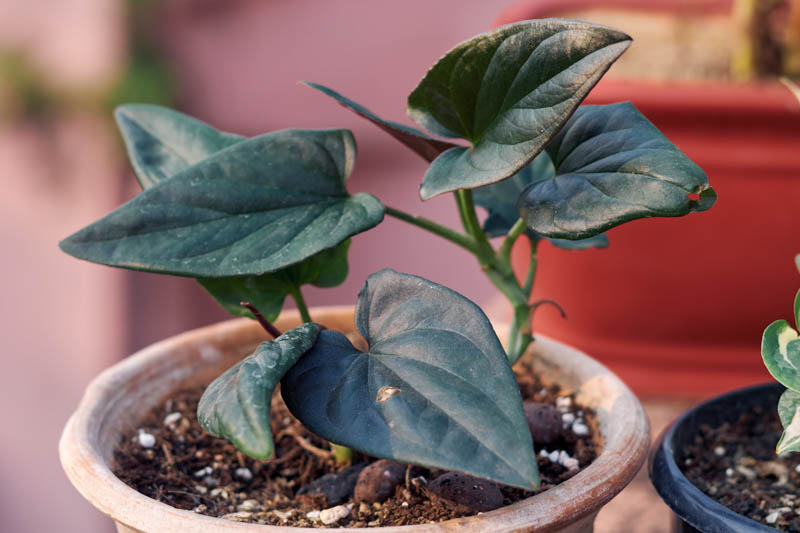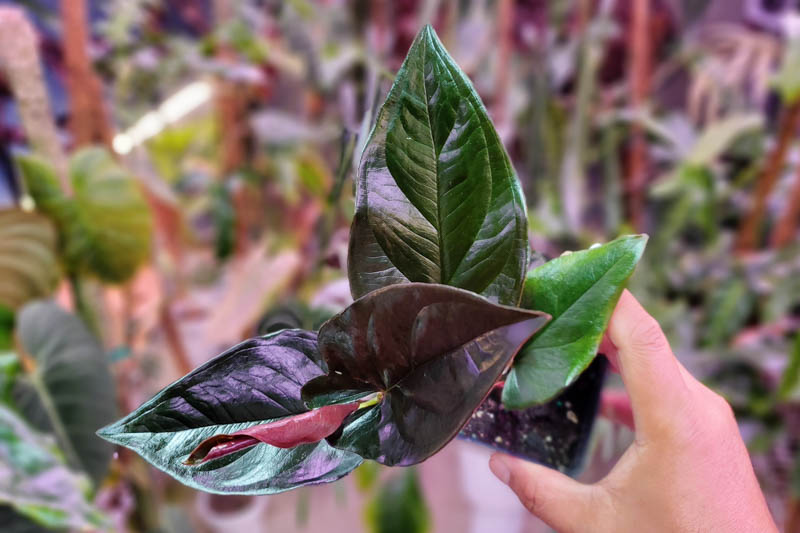Red Arrow Syngonium
Syngonium erythrophyllum, also known as the Red Arrow Syngonium, is a strikingly beautiful aroid known for its unique foliage and growing habits. This plant is ideal for both indoor plant enthusiasts and those looking to enhance their garden spaces in suitable climates.
Red Arrow Syngonium showcases stunning arrow-shaped leaves that are dark green with a velvety texture. The undersides of the leaves feature a rich burgundy hue, giving it the nickname ‘Red Arrow.’ The plant’s leaves change shape as they mature, moving from arrow-like to a more lobed appearance.
Native: This species is native to Central and South America, particularly thriving in the rainforests of Colombia and Panama, where it climbs trees and spreads along the ground. It belongs to the Araceae family, commonly known as the Arum family. This diverse family includes other well-known plants like Zantedeschia (Calla Lily), Caladium (Angel Wing), and Monstera (Swiss Cheese Plant).
Plant Type and Habit: Red Arrow Syngonium is an evergreen climbing vine that typically uses aerial roots to ascend trees and other surfaces in its natural habitat. When grown in homes or gardens, it can be trained on trellises or allowed to trail from hanging baskets.
Size: In a houseplant setting, it typically reaches heights of 3-6 feet (90-180 cm), with a spread of 1-2 feet (30-60 cm). Outdoors in optimal conditions, it can climb significantly higher.
Flowers: Like many aroids, it produces an inflorescence consisting of a spathe and spadix, though these are not commonly seen in household cultivation due to the plant’s focus on foliage growth.
Foliage: The plant’s lush, velvety foliage is its standout feature, with leaves that can grow quite large as the plant matures, adding a dramatic touch to its surroundings.
Hardiness: Red Arrow Syngonium is best suited for USDA zones 10-12. It does not tolerate cold well and should be protected from temperatures below 50°F (10°C).
Uses: It’s primarily used as an ornamental plant. It can be grown indoors as part of a houseplant collection or outdoors in tropical landscapes. It’s often displayed in hanging baskets, terrariums, or trained on trellises or poles.
Toxicity: Like many members of the Araceae family, Syngonium erythrophyllum is toxic if ingested. The plant contains calcium oxalate crystals that can cause irritation of the mouth, stomach, and skin, making it necessary to keep it away from pets and children.
Invasiveness: In tropical climates, Syngonium species can become invasive if not controlled. Care should be taken to manage growth and spread in such environments.
Benefits: The plant is highly valued for its air-purifying qualities, as it can help remove pollutants from indoor air. Its aesthetic appeal also contributes significantly to interior décor, enhancing the visual quality of living spaces.

The Red Arrow Syngonium is relatively easy to care for but does need specific conditions to thrive.
Light: Red Arrow Syngonium prefers bright, indirect light. It can tolerate some shade, but too little light may cause it to lose its vibrant coloration and become leggy. Avoid direct sunlight, which can scorch the leaves.
Soil: Use a well-draining, airy potting mix ideally suited for aroids. A mix of peat, perlite, and orchid bark often works well, providing the drainage and aeration that Syngoniums prefer.
Watering: Keep the soil consistently moist, but not waterlogged. Water when the top inch of soil feels dry to the touch. Reduce watering slightly during the winter months when the plant’s growth slows. Overwatering can lead to root rot, so ensure your pot has good drainage.
Humidity: This plant thrives in a high-humidity environment, which can be challenging to maintain in many indoor settings, especially during dry winter months. Increase humidity by placing it on a humidity tray, using a room humidifier, or regularly misting the plant.
Temperature: Keep the plant in a warm environment, avoiding temperatures below 60°F (15°C). Syngoniums are sensitive to cold drafts and sudden temperature fluctuations, which can cause stress and leaf drop.
Feeding: Feed the Red Arrow Syngonium every month during the growing season (spring and summer) with a balanced, water-soluble fertilizer diluted to half the recommended strength. Do not fertilize in the winter when the plant’s growth is dormant.
Pruning: Prune back any leggy or overgrown stems to maintain a bushy, compact appearance. This will encourage the plant to grow more densely and can be done at any time of year. Use clean, sharp scissors or pruning shears to make your cuts.
Repotting: Repot your Red Arrow Syngonium every 1-2 years or when it becomes root-bound. Choose a pot only one size larger than the current one to avoid overwatering issues. Fresh potting soil should be used to replenish nutrients.

Propagating Red Arrow Syngonium is a straightforward and rewarding process. This plant can be propagated via stem cuttings, which is an efficient way to multiply your plant collection or share with friends.
Select a Stem: Choose a healthy stem that has at least two or three leaves and a few nodes (the points on the stem where leaves are attached). It’s best to select a stem that is not currently flowering, as this will have more energy to devote to root development.
Cut the Stem: Using clean, sharp scissors or pruning shears, make a cut just below a node. The cutting should be about 4-6 inches long. Remove the leaves from the bottom half of the cutting to expose the nodes. This is where the roots will emerge.
Rooting the Cutting:
Location: Place the glass or pot in a location with bright, indirect light. Avoid direct sunlight, which can be too intense and harm the delicate new roots.
Care During Rooting: If you’re rooting in soil, keep the soil consistently moist but not soggy. Overwatering can cause the cutting to rot.
Maintaining high humidity can help the cutting root more successfully. You can cover the pot with a plastic bag to create a mini greenhouse effect, just be sure to open it occasionally for fresh air to prevent mold growth.
Transplanting: Once the roots are a few inches long (usually after about 4-6 weeks), the new plant can be transplanted into a larger pot if it was started in water. If it was started in soil, simply continue to care for it as normal, allowing it to grow.
Aftercare: Once established in its new pot, care for your new Syngonium as you would the parent plant: moderate light, consistent moisture, and regular feeding during the growing season.
Red Arrow Syngonium, while relatively easy to care for, can encounter several pests, diseases, and other common problems.
Mealybugs: These pests appear as small, white, fluffy spots on the leaves and stems. They suck sap from the plant, weakening it. Remove them using a cotton swab dipped in rubbing alcohol, or treat the plant with insecticidal soap.
Spider mites: These tiny pests can cause the leaves to become yellow and speckled. They thrive in dry conditions, so increasing humidity can help prevent them. If infestations occur, wash the plant with water and apply insecticidal soap or neem oil.
Aphids: These small pests also suck plant sap, causing the leaves to curl and distort. They can be controlled by spraying the plant with water or using insecticidal soap.
Root rot: Overwatering is a common cause of root rot in Syngoniums. Symptoms include yellowing leaves and a wilted appearance. Prevent this by ensuring the pot has good drainage and the soil does not remain soggy.
Leaf spot: Fungal or bacterial infections can cause spots on the leaves. Improve air circulation, avoid wetting the leaves when watering, and treat with fungicides if necessary.
Leggy Growth: Insufficient light can cause Syngoniums to become leggy as they stretch towards the light source. Move the plant to a brighter location with indirect sunlight.
Yellowing Leaves: If older leaves are yellowing, it may be a natural process of aging. However, if young leaves or multiple leaves are yellowing, it could be a sign of overwatering, poor drainage, or a nutrient deficiency.
Drooping Leaves: This can occur due to under or overwatering. Check the moisture level in the soil to determine if it needs water or needs to dry out.
| Hardiness |
10 - 12 |
|---|---|
| Plant Type | Houseplants, Climbers |
| Plant Family | Araceae |
| Exposure | Partial Sun |
| Season of Interest |
Spring (Early, Mid, Late) Summer (Early, Mid, Late) Fall Winter |
| Height |
3' - 6' (90cm - 180cm) |
| Spread |
1' - 2' (30cm - 60cm) |
| Spacing |
12" - 24" (30cm - 60cm) |
| Maintenance | Low |
| Water Needs | Average |
| Soil Type | Loam, Sand |
| Soil pH | Acid, Neutral, Alkaline |
| Soil Drainage | Moist but Well-Drained |
| Characteristics | Showy, Evergreen |
| Garden Uses | Ground Covers, Hanging Baskets, Patio And Containers |
| Hardiness |
10 - 12 |
|---|---|
| Plant Type | Houseplants, Climbers |
| Plant Family | Araceae |
| Exposure | Partial Sun |
| Season of Interest |
Spring (Early, Mid, Late) Summer (Early, Mid, Late) Fall Winter |
| Height |
3' - 6' (90cm - 180cm) |
| Spread |
1' - 2' (30cm - 60cm) |
| Spacing |
12" - 24" (30cm - 60cm) |
| Maintenance | Low |
| Water Needs | Average |
| Soil Type | Loam, Sand |
| Soil pH | Acid, Neutral, Alkaline |
| Soil Drainage | Moist but Well-Drained |
| Characteristics | Showy, Evergreen |
| Garden Uses | Ground Covers, Hanging Baskets, Patio And Containers |
How many Syngonium erythrophyllum (Red Arrow Syngonium) do I need for my garden?
| Plant | Quantity | |
|---|---|---|
| Syngonium erythrophyllum (Red Arrow Syngonium) | N/A | Buy Plants |
Create a membership account to save your garden designs and to view them on any device.
Becoming a contributing member of Gardenia is easy and can be done in just a few minutes. If you provide us with your name, email address and the payment of a modest $25 annual membership fee, you will become a full member, enabling you to design and save up to 25 of your garden design ideas.
Join now and start creating your dream garden!
Create a membership account to save your garden designs and to view them on any device.
Becoming a contributing member of Gardenia is easy and can be done in just a few minutes. If you provide us with your name, email address and the payment of a modest $25 annual membership fee, you will become a full member, enabling you to design and save up to 25 of your garden design ideas.
Join now and start creating your dream garden!